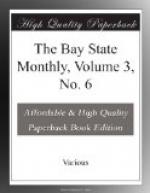In Mr. Paine’s physiognomy the most noticeable features are the broad, massive, Websterian forehead, and the sparkling eyes.
In summing up the characteristics of Mr. Paine as a lawyer and as a man, the writer, who was his pupil at Waterville Academy, and has enjoyed his friendship to this day, cannot do better than to cite the words of an acute observer who has known him intimately for many years. Chief Justice Appleton, of Maine, did not exaggerate, when he said: “He is a gentleman of a high order of intellect; of superior culture; in private life, one of the most genial of companions; in his profession, a profound and learned lawyer, as well as an accomplished advocate.”
To conclude,—if the subject of this imperfect sketch has occasion to regret his excessive devotion to his calling, he can have no other regrets. At the close of a long, most useful, and most honorable career, which has been marked throughout by the severest conscientiousness and the most scrupulous discharge of every professional duty, he is happily realizing that blessedness which Sir William Blackstone, when exchanging the worship of the Muses for that of Themis, prayed might crown the evening of his days:—
“Thus though my noon of life be
past,
Yet let my setting sun at last
Find out the still, the rural cell,
Where sage Retirement loves to dwell!
There let me taste the homefelt bliss
Of innocence and inward peace;
Untainted by the guilty bribe,
Uncursed amid the harpy tribe;
No orphan cry to wound my ear,
My honor and my conscience clear;
Thus may I calmly meet my end,
Thus to the grave in peace descend.”
* * * * *
PICKETT’S CHARGE.
By Charles A. Patch, mass., Vols.
In all great wars involving the destinies of nations, it is neither the number of battles, nor the names, nor the loss of life, that remain fixed in the mind of the masses; but simply the one decisive struggle which either in its immediate or remote sequence closes the conflict. Of the hundred battles of the great Napoleon, Waterloo alone lingers in the memory. The Franco-Prussian War, so fraught with changes to Europe, presents but one name that will never fade,—Sedan. Even in our own country, how few battles of the Revolution can we enumerate; but is there a child who does not know that Bunker Hill sounded the death-knell of English rule in the land? And now, but twenty years since the greatest conflict of modern times was closed at Appomattox, how few can we readily recall of the scores of blood-stained battle-fields on which our friends and neighbors fought and fell; but is there one, old or young, cultured or ignorant, of the North or of the South, that cannot speak of Gettysburg? But what is Gettysburg either in its first day’s Federal defeat, or its second day’s terrible slaughter around Little Round Top, without the third day’s immortal charge by Pickett and his brave Virginians. In it we have the culmination of the Rebellion. It took long years after to drain all the life-blood from the foe, but never again did the wave of Rebellion rise so gallantly high as when it beat upon the crest of Cemetery Ridge.




